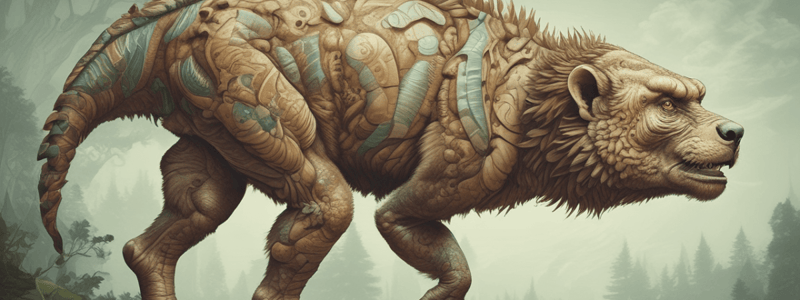Podcast
Questions and Answers
What hindered Charles Darwin's ability to provide evidence for his theory of evolution?
What hindered Charles Darwin's ability to provide evidence for his theory of evolution?
- The limited evidence available during his time (correct)
- The rarity of Staphylococcus aureus in the human population
- The availability of molecular data such as DNA and genes
- The lack of understanding of antibiotic resistance
What is the primary factor responsible for the development of antibiotic resistance in Staphylococcus aureus?
What is the primary factor responsible for the development of antibiotic resistance in Staphylococcus aureus?
- The use of antibiotics in the 1940s
- The discovery of penicillin and methicillin
- The similarity between ancient and modern mollusks
- The genetic makeup of the bacteria (correct)
What is the significance of fossil evidence, like ammonites, in the context of evolution?
What is the significance of fossil evidence, like ammonites, in the context of evolution?
- They show the development of antibiotic resistance
- They display similarities between ancient and modern organisms (correct)
- They demonstrate the concept of natural selection
- They provide evidence for the existence of Staphylococcus aureus
How long did it take for Staphylococcus aureus to become resistant to methicillin after its development?
How long did it take for Staphylococcus aureus to become resistant to methicillin after its development?
What is the primary habitat of Staphylococcus aureus in the human body?
What is the primary habitat of Staphylococcus aureus in the human body?
What is the significance of the example of MRSA in the context of evolutionary change?
What is the significance of the example of MRSA in the context of evolutionary change?
What is the primary pattern observed in the fossil record regarding the complexity of life forms?
What is the primary pattern observed in the fossil record regarding the complexity of life forms?
What is the term for the study of the distribution of organisms on Earth, which provides evidence for evolution?
What is the term for the study of the distribution of organisms on Earth, which provides evidence for evolution?
What is the term for structures that are similar in function but have different underlying structures, such as the pectoral fin of a shark and the flipper of a whale?
What is the term for structures that are similar in function but have different underlying structures, such as the pectoral fin of a shark and the flipper of a whale?
What is the evidence from molecular biology that suggests all living things evolved from a common ancestor?
What is the evidence from molecular biology that suggests all living things evolved from a common ancestor?
What is the term for the forelimbs of humans, cats, whales, and bats, which all have a humerus, radius, ulna, carpals, metacarpals, and phalanges?
What is the term for the forelimbs of humans, cats, whales, and bats, which all have a humerus, radius, ulna, carpals, metacarpals, and phalanges?
What is the prediction regarding the similarity in proteins between different species, based on their evolutionary relationships?
What is the prediction regarding the similarity in proteins between different species, based on their evolutionary relationships?
What is the primary characteristic of an adaptation in the context of descent with modification?
What is the primary characteristic of an adaptation in the context of descent with modification?
According to Ernst Meier's summary, what is the primary consequence of the struggle for survival?
According to Ernst Meier's summary, what is the primary consequence of the struggle for survival?
What is the significance of the observation that there is a limitation in resources?
What is the significance of the observation that there is a limitation in resources?
Which of the following is a necessary condition for a characteristic to be considered an adaptation?
Which of the following is a necessary condition for a characteristic to be considered an adaptation?
What is the primary consequence of differential reproduction?
What is the primary consequence of differential reproduction?
How did Charles Darwin view adaptations in the context of descent with modification?
How did Charles Darwin view adaptations in the context of descent with modification?
What is the primary mechanism driving the spread of beneficial adaptations in a population over time?
What is the primary mechanism driving the spread of beneficial adaptations in a population over time?
In the context of natural selection, what is the significance of variations in offspring production among individuals in a population?
In the context of natural selection, what is the significance of variations in offspring production among individuals in a population?
What is the primary advantage of larger body size and higher levels of aggression in male sea lions?
What is the primary advantage of larger body size and higher levels of aggression in male sea lions?
What is the relationship between the struggle for survival and the spread of beneficial adaptations in a population?
What is the relationship between the struggle for survival and the spread of beneficial adaptations in a population?
What is the expected outcome of natural selection acting on a population over time?
What is the expected outcome of natural selection acting on a population over time?
What is the role of natural selection in shaping the evolution of a species?
What is the role of natural selection in shaping the evolution of a species?
What is the primary mechanism that drives the change in species according to Lamarck's idea of 'use and disuse'?
What is the primary mechanism that drives the change in species according to Lamarck's idea of 'use and disuse'?
What is the primary difference between Lamarck's and Darwin's mechanisms of evolution?
What is the primary difference between Lamarck's and Darwin's mechanisms of evolution?
What is the outcome of a population of giraffes with a range of neck lengths, according to Darwin's theory of descent with modification?
What is the outcome of a population of giraffes with a range of neck lengths, according to Darwin's theory of descent with modification?
What is the role of genes in Darwin's theory of descent with modification?
What is the role of genes in Darwin's theory of descent with modification?
What is the primary advantage of Darwin's theory of descent with modification over Lamarck's idea of 'use and disuse'?
What is the primary advantage of Darwin's theory of descent with modification over Lamarck's idea of 'use and disuse'?
What is the significance of the example of a population of giraffes with a range of neck lengths in Darwin's theory of descent with modification?
What is the significance of the example of a population of giraffes with a range of neck lengths in Darwin's theory of descent with modification?
What was the primary limitation of Jean-Baptiste Lamarck's mechanism for species change?
What was the primary limitation of Jean-Baptiste Lamarck's mechanism for species change?
How did Charles Lyell's view of the Earth's history contrast with George Cuvier's catastrophism?
How did Charles Lyell's view of the Earth's history contrast with George Cuvier's catastrophism?
What was the role of Aristotle's 'scale of nature' in the development of evolutionary thought?
What was the role of Aristotle's 'scale of nature' in the development of evolutionary thought?
How did the Judeo-Christian culture influence the view of life and evolution?
How did the Judeo-Christian culture influence the view of life and evolution?
What was the contribution of George Cuvier to the development of evolutionary thought?
What was the contribution of George Cuvier to the development of evolutionary thought?
What was the primary influence of Greek philosophers on the development of evolutionary thought?
What was the primary influence of Greek philosophers on the development of evolutionary thought?
What is the primary factor driving the adaptation of populations to their environment?
What is the primary factor driving the adaptation of populations to their environment?
What is the term for the process by which a single species splits into two or more distinct species?
What is the term for the process by which a single species splits into two or more distinct species?
What is the term for the study of evolutionary relationships between organisms, often represented in a diagram?
What is the term for the study of evolutionary relationships between organisms, often represented in a diagram?
What is the term for the process by which humans intentionally select for certain traits in a population, often leading to adaptations?
What is the term for the process by which humans intentionally select for certain traits in a population, often leading to adaptations?
What is the term for the ability of an organism to survive and reproduce in its environment, often influenced by adaptations?
What is the term for the ability of an organism to survive and reproduce in its environment, often influenced by adaptations?
What is the term for the structures that are similar in function but have different underlying structures, such as the pectoral fin of a shark and the flipper of a whale?
What is the term for the structures that are similar in function but have different underlying structures, such as the pectoral fin of a shark and the flipper of a whale?
What is the primary implication of the phrase 'descent with modification' in the context of evolution?
What is the primary implication of the phrase 'descent with modification' in the context of evolution?
What is the primary difference between artificial and natural selection?
What is the primary difference between artificial and natural selection?
What is the ultimate outcome of a struggle for survival in a population?
What is the ultimate outcome of a struggle for survival in a population?
How does natural selection lead to the adaptation of a population over time?
How does natural selection lead to the adaptation of a population over time?
What is the significance of the example of broccoli, cabbage, and Brussels sprouts in the context of evolution?
What is the significance of the example of broccoli, cabbage, and Brussels sprouts in the context of evolution?
What is the primary consequence of the observation that individuals in a population show great variation in their characteristics?
What is the primary consequence of the observation that individuals in a population show great variation in their characteristics?
What is the primary mechanism by which species evolve, according to Charles Darwin's theory of descent with modification?
What is the primary mechanism by which species evolve, according to Charles Darwin's theory of descent with modification?
Which of the following is a key principle of uniformitarianism, as proposed by Charles Lyell?
Which of the following is a key principle of uniformitarianism, as proposed by Charles Lyell?
What is the primary difference between Lamarck's and Darwin's mechanisms of evolution?
What is the primary difference between Lamarck's and Darwin's mechanisms of evolution?
Which of the following is a consequence of the process of natural selection, as described by Charles Darwin?
Which of the following is a consequence of the process of natural selection, as described by Charles Darwin?
What is the term for the study of the history of life on Earth, which draws on evidence from geology and fossils?
What is the term for the study of the history of life on Earth, which draws on evidence from geology and fossils?
Which of the following is a key concept in understanding the evolution of species, as described by Charles Darwin?
Which of the following is a key concept in understanding the evolution of species, as described by Charles Darwin?
Flashcards are hidden until you start studying
Study Notes
- Charles Darwin needed to provide evidence for his theory of evolution through natural selection, but the evidence available during his time was limited.
- Much of the evidence used today to describe evolutionary relationships between groups was not available during Darwin's time, including molecular similarities such as DNA, genes, and mutations.
- Some bacteria, like methicillin-resistant Staphylococcus aureus (MRSA), can evolve quickly and become resistant to antibiotics, demonstrating evolutionary change at a micro scale.
- Staphylococcus aureus is a bacterium present in 40% of the human population, living on skin and in the nose and mouth, but usually doesn't cause problems.
- In the 1940s, penicillin was discovered, and it could easily kill Staphylococcus aureus, but it took only a couple of years for the bacterium to become resistant to penicillin.
- Methicillin was developed to combat the resistance, but it took only two years for Staphylococcus aureus to become resistant to methicillin as well.
- The genetic makeup of these bacteria is responsible for the changes, providing evidence for evolution.
- Fossils were one type of evidence available during Darwin's time, and they show similarities between ancient organisms and their modern counterparts.
- Ammonites, extinct mollusks, show similarities to modern mollusks like the chambered nautilus, with features like spiral patterns on their shells and chambers.
- The fossil record shows a pattern of increasing complexity of life forms over time, with simpler forms found in older layers of rocks and more complex forms found in newer layers.
- Biogeography, the study of the distribution of organisms on earth, provides evidence for evolution, as island species are often similar to species found on the nearest continent.
- Charles Darwin inferred that the Galapagos finches evolved from finches in South America due to their similarities and the fact that they are more different from finches found in other parts of the world.
- Comparative anatomy shows similarities in body parts between different organisms, such as the forelimbs of humans, cats, whales, and bats, which all have a humerus, radius, ulna, carpals, metacarpals, and phalanges.
- These similarities are due to homologous structures, which are derived from a common ancestor, and are not the result of convergent evolution.
- Homologous structures are different from analogous structures, which are similar in function but have different underlying structures, such as the pectoral fin of a shark and the flipper of a whale.
- Molecular biology provides evidence for evolution through similarities in DNA and proteins between different species.
- All living things have DNA made up of the same four bases: adenine, thymine, cytosine, and guanine, suggesting that they all evolved from a common ancestor.
- Similarities in proteins, such as hemoglobin, between closely related species provide further evidence for evolution, with more differences predicted between more distant species.
Studying That Suits You
Use AI to generate personalized quizzes and flashcards to suit your learning preferences.




